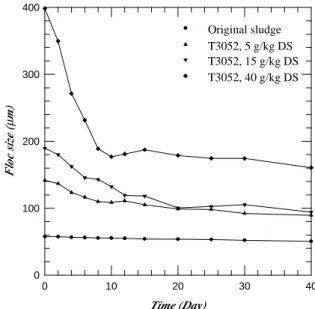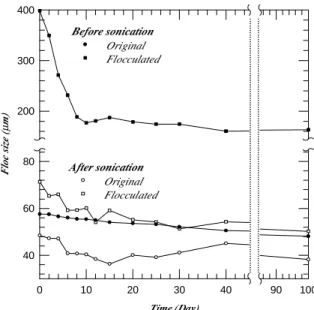總計劃及子計劃一:污泥之前處理
計畫類別: 整合型計畫 計畫編號: NSC90-2211-E-002-048-執行期間: 90 年 08 月 01 日至 91 年 10 月 31 日 執行單位: 國立臺灣大學化學工程學系暨研究所 計畫主持人: 李篤中 共同主持人: 劉志成,張碧芬 計畫參與人員: 朱敬平、王之仲 報告類型: 精簡報告 報告附件: 國際合作計畫研究心得報告 處理方式: 本計畫可公開查詢中
華
民
國 92 年 5 月 21 日
行政院國家科學委員會專題研究計畫成果報告
污泥處理技術之整合型研究-總計畫及子計畫一:污泥之前處理
計畫編號:NSC 90-2211-E-002-048
執行期限:90 年 8 月 1 日至 91 年 7 月 31 日
主持人:李篤中 教授
計畫參與人員:朱敬平、王之仲
執行機構及單位名稱:國立台灣大學化學工程學系
1. 中文摘要 本計劃探討以低功率超音波破碎對聚電解質絮凝後之活性污泥進行前處 理,以增進其厭氧消化效率;與先前研究相比,在此所施用之功率顯然偏低而不 足以完全破碎污泥膠羽顆粒。從觀測消化過程中甲烷的產量與顆粒特性,可以發 現以陽離子型聚電解質絮凝污泥之後會在消化初期增加甲烷氣之產量,但在後期 則有抑制產氣之情形;在以低功率超音波 (0.33 Watt/ml) 處理二十分鐘後,甲烷 氣的產生都明顯的增加,並消除了先前陽離子型聚電解質會抑制產氣之情形。在 本文中將進一步探討其中之機制。 Abstr actIn this project the polyelectrolyte-flocculated biosolids were pretreated by ultrasonication in low power level to enhance the digestion performance. Compared with the previous studies, the ultrasound applied here could not completely disrupt the floc particles. While monitoring the time evolution of methane production and floc properties, it is shown that cationic polyelectrolyte flocculation enhanced the methane production in the initial stage of biosolids digestion but inhibited in contrary in the later stage. After treated by low-power ultrasonication (0.33 Watt/ml) for 20 minutes, the methane production of biosolids largely increased and reduced the negative effects brought by cationic polyelectrolyte flocculant.
關鍵詞:厭氧消化、超音波破碎、甲烷產氣、膠羽特性
2. Introduction
Anaerobic digestion is a widely used stabilization process for reducing biosolids volume and producing bio-gas. To enhance its sedimentation rate prior to digestion process, chemical flocculants are added to biosolids. However, their role on the anaerobic digestion of biosolids had not been satisfactorily explored. Gossett et al.
(1978) noted the reduction of methane production and volatile solids destruction ratio of an anaerobic digested wastewater biosolids when the organic coagulants (low MW) were present. On the other hand, El-Manouni et al. (1998) found that the synthetic
acetogenic and methanogenic bacteria.
In Chu et al. (2001), the ultrasound was noted to completely destroy the global
structure of flocs and release a large part of the organics from the sludge particles. This process is efficient but must exhaust a huge amount of energy if applied in field. This work first examined the impact of polyelectrolyte flocculant on the anaerobic digestion efficiency of waste-activated biosolids, including the methane production and floc characteristics. In the second part we examined the effects of applying ultrasound pretreatment in low power level on the floc characteristics of anaerobically digested activated biosolids using cationic polyelectrolyte as the conditioner. We demonstrated herein that insufficient ultrasound dosage is not to directly release insolubles into the suspension, but to make the organics more easily attacked by the hydrolyzed enzyme. Some comments regarding the influence of floc size on digestion efficiency are also offered.
3. Exper imental
3.1 The Samples
Waste activated biosolids were taken from a wastewater treatment plant in the Presidential Enterprise Co., Taoyuan, Taiwan. The total solid content was measured as 9,390 mg/l and the true density of dried solid in biosolids was 1,470 kg/m3. The pH value of original biosolids was approximately 6.7.
3.2 Flocculation Conditioning and Sonication
Cationic polyelectrolyte T3052 (cationic polyacrylamide) was provided by Kai-Guan Inc., Taiwan, with molecular weight of 107 and charge density of 20%. Biosolids sample was first put in a standard mixing vessel, and pre-calculated amount of flocculant solution was then gradually poured into the mixing vessel with 200 rpm of stirring for 5 min, followed by 50 rpm for another 20 min. The flocculant dose adopted in this study is 40 g-T3052/kg-DS, which leads to the floc ζ potential largely deviated from the neutralization point.
The original and the conditioned biosolids sample were sonicated in a 500-ml beaker with the assistance of a cell-disrupter (SONICATOR XL-2020, Heat system-Ultrasonics, Inc.) allocated at 2 cm above the beaker bottom. The frequency of ultrasound was 20 kHz. The sonication power was 0.33 Watt/ml and sonication time 20 minutes. The temperature of biosolids was kept at 25oC in a water bath for preventing the possible temperature effect. In following section we denoted the original biosolids as the sample O; the cationic polymer flocculated biosolids (40 g-T3052/kg-DS), the sample F; the original biosolids subject to sonication as the sample OS, and the flocculated sample F after sonication, the sample FS.
3.3 Anaerobic Digestion and Related Tests
All digestion experiments were performed using 25 ml serum bottles in an anaerobic glove box (Forma Scientific, model 1025 S/N). 5 ml biosolids (original or flocculated) mixed with 1 ml anaerobes K8 and 4 ml medium were poured into the serum bottles. K8 was collected from the bottom sediment at some known site of Tam-Shui River (near Taipei), March 1998 and adapted by adding 0.1 ppm PCB and medium to 500 g sediment at 14-day intervals under static incubation at 35oC without light for more than 2 years. Serum bottles were then capped with butyl rubber stoppers and wrapped in aluminum foil to prevent possible photolysis. These bottles (over 40 in number for each sample) were incubated at 35oC without shaking. Methane production was quantified with a gas chromatography (Sigma 3B Perkin-Elmer) equipped with a packed column (200x0.5 cm, 80/100 porapal Q; Supecol, Bellefonte, PA) and flame-ionization detector.
4. Results and Discussions
4.1 Methane productionFigure 1 illustrates amounts of methane yield for the original and the
T3052-flocculated biosolids. As Fig. 1 shows, during the first six days of digestion, the T3052-flocculated biosolids generate methane more rapidly than biosolids does the original biosolids. The digestion rate of biosolids flocculated at a dosage above 15 g/kg DS declines with time. Following ten days of digestion, the methane production curves for the original and the flocculated biosolids at a dosage under 5 g/kg DS converge. The aforementioned experimental results clearly reveal that the presence of flocculants can enhance the efficiency of the first stage of digestion, but in the later stages the flocculants inhibit digestion if biosolids is conditioned with a high dosage cationic polymer. Flocculants take different roles in different stages of digestion.
Time (Day) 0 10 20 30 40 M et h a n e yi el d (g C H4 /k g D S ) 0 50 100 Original sludge T3052, 5g/kg DS T3052, 15g/kg DS T3052, 40g/kg DS
Fig. 1 Methane production amount for anaerobic digestion of biosolids.
Figure 2 illustrates the methane production of biosolids after ultrasonication.
The sonication pre-treatment could markedly enhance both the methane production rate as well as its ultimate yield. An enhancement of 290% and 480% is achieved. Meanwhile, the corresponding ultimate yields increase by 104% and 260% for the original and the flocculated biosolids, respectively.
Time (day) 0 10 20 30 40 90 100 M et h a n e p ro d u ct io n (g /k g D S ) 0 100 200 300 Original Flocculated Original Flocculated Before sonication After sonication
Fig. 2 Methane production amount
for anaerobic digestion of biosolids after sonication.
Therefore, although the presence of polyelectrolyte in long-term tests could retard the anaerobic digestion process, the ultrasonic pre-treatment can markedly enhance the digestion. Furthermore, compared with sample OS, the presence of polyelectrolyte can further increase the ultimate yield for sample FS by approximately 10%.
4.2 Changes in floc char acter istics
Figure 3 depicts the mean floc sizes of the original and flocculated biosolids.
The floc size decreases as the digestion proceeds, implying the deterioration of the floc structure. A dramatic size reduction is noticeable for the T-3052 flocculated biosolids. The size of 40 g/kg DS flocculated biosolids is reduced by more than 55% during the first ten days of digestion. The size reduction is less significant in cases with a lower dosage of 5 g/kg DS. Microphotographs showed that the original biosolids exhibits a loose floc structure in the presence of filamentous microorganism. Partial disintegration of floc structure is observed after digestion, but the complete floc structure remains almost intact. After 30 days of digestion, the entire flocculated aggregate is largely deteriorated and the flocs resemble the original flocs.
After sonication, Figur e 4 depicts that the flocs of original and flocculated biosolids were decreased to the size near to the level of original biosolids floc. Also the floc size decreases as the digestion proceeds. The sample OS and sample FS resemble each other in appearance. The global structures for original biosolids and for flocculated sample after digestion have been partially deteriorated, with the former more readily damaged in structure than the latter. This is probably due to the much stronger floc matrix by the action of flocculants. After 30 days of digestion, partial disintegration of floc structure is noticeable, but the entire floc structure has been retained. Time (Day) 0 10 20 30 40 F lo c si ze (µ m ) 0 100 200 300 400 Original sludge T3052, 5 g/kg DS T3052, 15 g/kg DS T3052, 40 g/kg DS
Time (Day) 0 10 20 30 40 90 100 F lo c si ze (µ m ) 40 60 80 200 300 Original Flocculated After sonication
Fig. 4 Floc size of biosolids during digestion after sonication 4.3 Possible mechanism
The digestion of activated biosolids, original or flocculated, comprises of the following two stages. Before day 10 (phase I), one noted the marked changes in all process characteristics, and subsequently, all these process parameters gradually converge and reach a plateau state, while the remaining 27-37% of methane is produced in a 20-30 day period of time (phase II). The phase I digestion could gain the most of the benefits from the biosolids digestion, regardless of the presence of flocculants or the application of ultrasound. The presence of flocculant molecules could enhance phase-I digestion, probably being attributed to the extra carbon source. In the subsequent phase II the flocculant molecules hinder the digestion. Application of “weak” ultrasound pre-treatment could markedly enhance digestion efficiency for both original (sample OS) and flocculated biosolids (sample FS). Although the total ultrasonic energy input is not sufficient to completely destroy the floc interior and to effectively release the organics from the solid phase, it has satisfactorily enhanced the subsequent anaerobic digestion processes. This is not consistent with the literature works suggesting that the pre-treatment process should directly transformed the available organics into soluble forms (Chiu et al., 1997).
Furthermore, compared with sample OS, the presence of polyelectrolyte can further increase the ultimate yield of methane for sample FS by approximately 10%. Notably the polyelectrolyte existed in sample FS is at a weight percent of approximately 4%. If taking the mass loss for the biosolids digestion as 30-40% of its original weight, as commonly noted in practice, then the excess 10% methane production for sample FS could be regarded as to the end-product from the digested polyelectrolyte. These results imply that the ultrasound apparently not only helps hydrolyze the biosolids particles, but also leads to easy digestion to the
polyelectrolyte molecules.
5. Conclusions
This study considered the effects of polyelectrolyte flocculants on the anaerobic digestion of waste-activated biosolids. The cationic flocculant efficiently conditioned the biosolids, which presented no significant toxicity to the studied microbial population. In the first stage of digestion (< 6 days) the presence of polyelectrolyte flocculants enhanced methane production and reduced the floc size. During the subsequent stage (> 10 days), applying a high dosage (>15 g/kg DS) T3052 significantly reduced the efficiency of digestion. Such a result was attributed to the much larger floc size of T3052-flocculated flocs and their much denser interior. Sonication could largely enhance the methane production of both original and flocculated biosolids, though it could not fully deteriorate the floc structure.
6. Refer ences
Chiu, Y. C., Chang, C. N., Lin, J. G. and Huang, S. J. (1997) Alkaline and ultrasonic pretreatment of sludge before anaerobic digestion. Wat. Sci. Tech., 36(11),
155-162.
Chu, C. P., Lee, D. J., Chang, B. V. and Liao, C. S. (2001) Observations on changes in ultrasonically treated waste activated sludge. Wat. Res., 35, 1038-1046.
El-Manouni, R., Leduc, R. and Guiot, S. R. (1998) Influence of synthetic and natural polymers on the anaerobic granulation process. Wat. Sci. Tech., 38(8-9), 341-347.
Gossett, J. M., McCarty, P. L., Wilson, J. C. and Evans, D. S. (1978) Anaerobic digestion of biosolids from chemical treatment. Res. J. Wat. Pollut. Control Fed., 50, 533-542.


